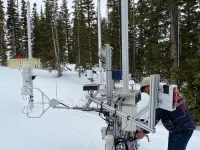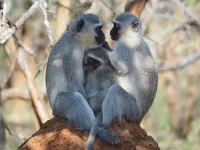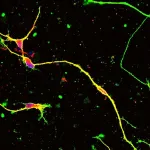(Press-News.org) Tim Garrett has devoted his scientific career to characterizing snowflakes, the protean particles of ice that form in clouds and dramatically change as they fall to Earth.
Now the University of Utah atmospheric scientist is unlocking the mystery of how snowflakes move in response to air turbulence that accompanies snowfall using novel instrumentation developed on campus. And after analyzing more than half a million snowflakes, what his team has discovered has left him astonished.
Rather than something incomprehensibly complicated, predicting how snowflakes move proved to be surprisingly simple, they found.
“How snowflakes fall has attracted a lot of interest for many decades because it is a critical parameter for predicting weather and climate change,” Garrett said. “This is related to the speed of the water cycle. How fast moisture falls out of the sky determines the lifetime of storms.”
'Letters sent from Heaven'
The famed Japanese physicist Ukichiro Nakaya termed snow crystals “letters sent from heaven” because their delicate structures carry information about temperature and humidity fluctuations in the clouds where crystal basal and prism facets competed for water vapor deposition.
While every snowflake is believed to be completely unique, how these frosty particles fall through the air—as the accelerate, drift and swirl—follows patterns, according to new research by Garrett and colleagues in the College of Engineering. Snowflake movement has important implications for weather forecasting and climate change, even in the tropics.
“Most precipitation starts as snow. How question of how fast it falls affects predictions of where on the ground precipitation lands, and how long clouds last to reflect radiation to outer space,” Garrett said. “It can even affect forecasts of a hurricane trajectory.”
Also involved with the research are Dhiraj Singh and Eric Pardyjak of the U’s Department of Mechanical Engineering
To study snowflake movement, the team needed a way to measure individual snowflakes, which has been a challenging puzzle for years.
“They have very low masses. They may only weigh 10 micrograms, a hundredth of a milligram, so they cannot be weighed with very high precision,” Garrett said.
Working with engineering faculty, Garrett developed instrumentation called the Differential Emissivity Imaging Disdrometer, or DEID, which measures snowflakes’ hydrometeor mass, size and density. This device has since been commercialized by a company Garrett co-founded called Particle Flux Analytics. The Utah Department of Transportation has deployed the equipment in Little Cottonwood Canyon to help with avalanche forecasting, he said.
For Garrett’s field experiments, his team set it up at Alta, the famed ski destination and Utah's snowiest place for the winter of 2020-21. The instrumentation was deployed alongside measurements of air temperature, relative humidity and turbulence, and placed directly beneath a particle tracking system consisting of a laser light sheet and a single-lens reflex camera.
“By measuring the turbulence, the mass, density and size of the snowflakes and watching how they meander in the turbulence,” Garrett said, “we are able to create a comprehensive picture that hadn't been able to be obtained before in a natural environment before.”
The findings were not what the team expected.
Despite the intricate shapes of snowflakes and the uneven movement of the air they encounter, the researchers found they could predict how snowflakes would accelerate based on a parameter known as the Stokes number (St), which reflects how quickly the particles respond to changes in the surrounding air movements.
When the team analyzed the acceleration of individual snowflakes, the average increased in a nearly linear fashion with the Stokes number. Moreover, the distribution of these accelerations could be described by a single exponential curve independent of Stokes number.
The researchers found that the same mathematical pattern could be connected to how changing snowflake shapes and sizes affect how fast they fall, suggesting a fundamental connection between the way the air moves and how snowflakes change as they fall from the clouds to the ground.
“That, to me, almost seems mystical,” Garrett said. “There is something deeper going on in the atmosphere that leads to mathematical simplicity rather than the extraordinary complexity we would expect from looking at complicated snowflake structures swirling chaotically in turbulent air. We just have to look at it the right way and our new instruments enable us to see that.”
Garrett’s study, titled “A universal scaling law for Lagrangian snowflake accelerations in atmospheric turbulence,” is to be published in the journal Physics of Fluids, published by the American Institute of Physics. Funding came from the National Science Foundation.
END
The science behind snowflakes
In a study that could enhance weather forecasting, Utah researchers discover that how snowflakes move is astonishingly predictable.
2023-12-19
ELSE PRESS RELEASES FROM THIS DATE:
COVID-19 infection causes teen’s vocal cord paralysis in first-of-its-kind case
2023-12-19
Physician-researchers from Mass Eye and Ear, a member of Mass General Brigham, report the first pediatric case of bilateral vocal cord paralysis after COVID-19 (SARS-CoV-2) infection. The patient, an otherwise healthy 15-year-old female, came to the emergency department at Massachusetts General Hospital with symptoms of respiratory distress nine days after diagnosis with SARS-CoV-2 infection. Examination with an endoscope revealed bilateral vocal cord paralysis, which is an immobility of both vocal cords found in the larynx or voice box. The researchers concluded that this paralysis was likely a downstream ...
Vervet monkeys follow different social “norms” and respond to “peer pressure,” new long-term study shows
2023-12-19
People living in different communities follow different social customs or norms. In some places, for instance, it might be standard practice to greet each person you see on the street, while in others that simply isn’t done. In some cases, such differences may even vary from one neighborhood to the next. Now researchers reporting in the journal iScience on December 19 have found similarly varied social traditions and styles among neighboring groups of vervet monkeys.
“We report the existence of behavioral traditions of social customs in vervet ...
Would you like to groom me?
2023-12-19
Researchers at UNIL’s Department of Ecology and Evolution reveal the existence of social traditions in vervet monkeys. This work was published in iScience on December 19, 2023.
British tits have learned from each other how to pierce the lids of milk bottles left on doorsteps. On the island of Koshima, Japanese macaques started washing sweet potatoes to rid them of sand. The animal realm is full of examples of traditions linked to food, tool use or hunting techniques that have spread within specific communities. However, few traditions of social nature, i.e. how individuals interact with each other, have been described.
A ...
Snowflakes swirling in turbulent air as they fall through a laser light sheet. Credit: Singh et al.
2023-12-19
WASHINGTON, Dec. 19, 2023 – A winter wonderland calls to mind piles of fluffy, glistening snow. But to reach the ground, snowflakes are swept into the turbulent atmosphere, swirling through the air instead of plummeting directly to the ground.
The path of precipitation is complex but important to more than just skiers assessing the potential powder on their alpine vacation or school children hoping for a snow day. Determining snowflake fall speed is crucial for predicting weather patterns and measuring climate ...
Clinicians could be fooled by biased AI, despite explanations
2023-12-19
AI models in health care are a double-edged sword, with models improving diagnostic decisions for some demographics, but worsening decisions for others when the model has absorbed biased medical data.
Given the very real life and death risks of clinical decision-making, researchers and policymakers are taking steps to ensure AI models are safe, secure and trustworthy—and that their use will lead to improved outcomes.
The U.S. Food and Drug Administration has oversight of software powered by AI and machine learning used in health care and has issued guidance for developers. This includes a call to ensure the ...
Measuring the impact of AI in the diagnosis of hospitalized patients
2023-12-19
About The Study: Although standard artificial intelligence (AI) models improve diagnostic accuracy, systematically biased AI models reduced diagnostic accuracy, and commonly used image-based AI model explanations did not mitigate this harmful effect in this multicenter randomized clinical vignette survey study involving hospitalist physicians, nurse practitioners, and physician assistants from 13 states.
Authors: Michael W. Sjoding, M.D., of the University of Michigan Medical School, and Jenna Wiens, Ph.D., of the University of Michigan, Ann Arbor, are the corresponding authors.
To ...
Disparities in preoperative goals of care documentation in veterans
2023-12-19
About The Study: In this study of 13,000 patients, few patients undergoing surgical procedures completed preoperative life-sustaining treatment documentation, with disparities in documentation rates based on race, ethnicity, rurality of patient residence, history of mental health disability, and access to high-volume facilities within a Veterans Affairs cohort.
Authors: Adela Wu, M.D., of the U.S. Department of Veterans Affairs, in Palo Alto, California is the corresponding author.
To access the embargoed study: Visit our For The Media website at this link https://media.jamanetwork.com/
(doi: ...
Screening for social determinants of health during primary care and emergency department encounters
2023-12-19
About The Study: This study found that patients screened in the emergency department (ED) were more likely to screen positive for Social Determinants of Health (SDOH) needs, which is not surprising given utilization patterns. Patients with SDOH needs have limited health care access and are more likely to use the ED than primary care. Although primary care–based screening found lower SDOH needs relative to the ED, primary care may be better optimized to follow and ultimately address SDOH needs.
Authors: Stacie ...
Study uncovers major hidden human-driven bird extinctions
2023-12-19
Humans have wiped out around 1,400 bird species – twice as many as previously thought – with major implications for the ongoing biodiversity crisis, a new study has found.
Many of the world’s islands were previously untouched paradises, but the arrival of people to places like Hawaii, Tonga and the Azores led, over time, to far-reaching impacts including deforestation, overhunting and the introduction of invasive species. Consequently, bird species were wiped out.
While the demise of many birds since the 1500s has been recorded, our knowledge of the fate of species before this relies on fossils, ...
Promising new treatment for a common hereditary nerve disease
2023-12-19
Researchers from Tokyo Medical and Dental University (TMDU) develop a genome-editing technique that reduces disease-causing proteins and related issues in cells from a patient with Charcot–Marie–Tooth disease type 1A
Tokyo, Japan – Scientific advances in the last century have changed our world significantly. For example, the world of genetics has opened doors to a myriad of possibilities: augmented human capabilities, cures for diseases, and even changes to the course of evolution.
In a study published last month in Communications Medicine, researchers from Tokyo Medical and Dental University (TMDU) have unveiled a groundbreaking genome-editing technique. This ...
LAST 30 PRESS RELEASES:
Implant provides lasting relief for treatment-resistant depression
Autologous T cell therapy targeting multiple antigens shows promise treating pancreatic cancer
First extensive study into marsupial gut microbiomes reveals new microbial species and antimicrobial resistance
Study debunks myth of native Hawaiians causing bird extinctions
Tailored biochar could transform how crops grow, resist disease, and clean polluted soils
Biochar-based enzyme technology offers new path for cleaner water and soil
Biochar helps farmland soils withstand extreme rain and drought by steadying carbon loss
New study reveals major gaps in global forest maps
Ochsner Health names Dr. Timothy Riddell executive vice president and chief operating officer
Can future-focused thoughts help smokers quit?
From brain scans to alloys: Teaching AI to make sense of complex research data
Stem Cell Reports seeks early career editors to join the editorial board
Signs of ancient life turn up in an unexpected place
Pennington Biomedical researchers explore factors behind body’s ability to regulate weight
Zhongping Lee awarded the Nils Gunnar Jerlov Medal
Deborah S. Kelley awarded the Wallace S. Broecker Medal
Novel immunotherapy demonstrates early potential to overcome resistance to immune checkpoint therapy
LLM treatment advice agrees with physician recommendations in early-stage HCC, but falls short in late stage
Deep learning model trained with stage II colorectal cancer whole slide images identifies features associated with risk of recurrence – with higher success rate than clinical prognostic parameters
Aboard the International Space Station, viruses and bacteria show atypical interplay
Therapies that target specific type of cell death may be an effective avenue for cancer treatment, UTHealth Houston researchers find
CHEST releases guideline on biologic management in severe asthma
Scientists create a system for tracking underwater blackouts
Fruit fly pigmentation guides discovery of genes that control brain dopamine and sleep
World's largest physics conference to be held in Denver and online this March
New mega-analysis reveals why memory declines with age
Understanding ammonia energy’s tradeoffs around the world
UTHealth Houston researchers map gene disruptions in sporadic early onset Alzheimer’s disease across key brain regions
Minimum wage increases are linked to safer pregnancies
Left in the cold: Study finds most renters shut out of energy-saving upgrades
[Press-News.org] The science behind snowflakesIn a study that could enhance weather forecasting, Utah researchers discover that how snowflakes move is astonishingly predictable.






